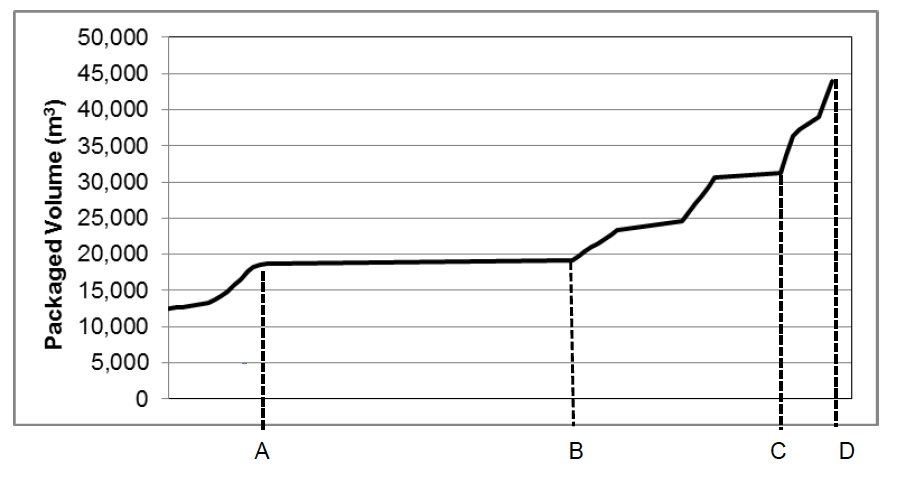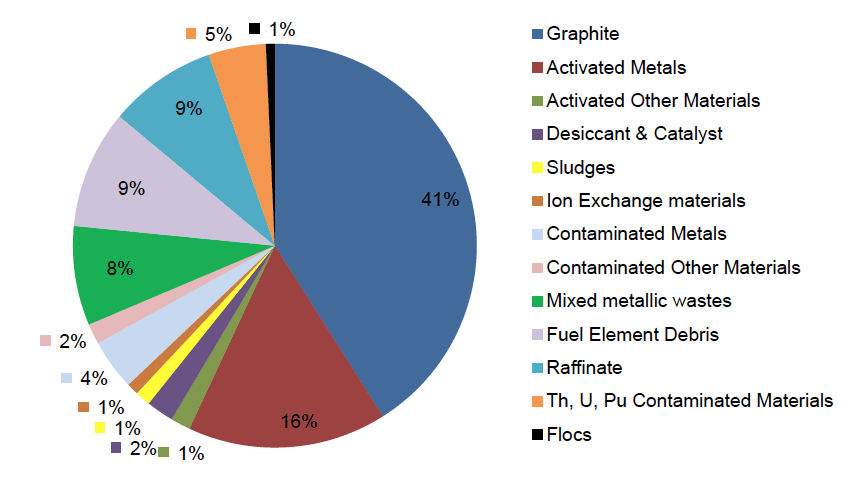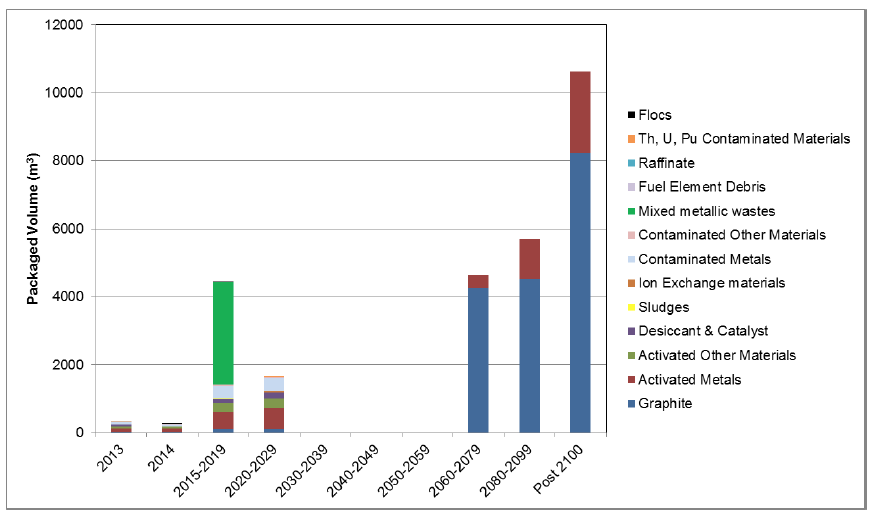Higher-activity radioactive waste: implementation strategy
Implementation strategy for Scotland's policy on higher-activity radioactive waste.
Annex B Current Management of Higher Activity Waste in Scotland
Summary of wastes covered by the Policy/Strategy
A.12)Higher activity waste produced in Scotland arises from operations in the nuclear and non-nuclear industries as well as from defence establishments.
A.13)The Policy and Strategy apply to the operational and decommissioning waste generated at nuclear sites and from non-nuclear industry activities throughout Scotland. The waste from these nuclear sites and from non-nuclear industry sectors is regulated under the Radioactive Substances Act 1993 ( RSA93).
A.14)The Policy and Strategy do not apply to radioactive waste from those defence establishments which are not subject to regulation under RSA93. This includes waste arising from the operational nuclear submarine bases on the Clyde and Vulcan and from the decommissioning and dismantling of redundant nuclear submarines including those berthed at the former defence establishment at Rosyth.
A.15)The Policy and Strategy also do not apply to radioactive waste which has already been dealt with under the policies of previous governments. This includes radioactive waste which is the subject of previous or existing contractual arrangements, including waste sent to facilities outside of Scotland, including Sellafield.
A.16)The Policy and Strategy do not apply to High Level Waste ( HLW), as there is no HLW in Scotland, or to radioactive substances and material which are not currently classified as radioactive waste, such as spent nuclear fuel, plutonium, uranium or other such radioactive fuels and materials.
A.17)If, in the future, HLW arises in Scotland or any of the substances and materials described in A16 were to be classified as waste or were to be classified as HLW, as is probable for such materials, they would not be covered by the 2011 Policy nor this Strategy.
Overview of Scottish Higher Activity Waste
A.18)It is estimated that once the nuclear licensed sites in Scotland are decommissioned there will be approximately 41,400m 3 of packaged waste covered by this Policy to deal with [21] . Under current decommissioning plans this work will not be complete until approximately 2120.
A.19)Approximately one third of the total volume of HAW in Scotland has already been produced. Of this volume some has been processed, and is being held in stores, but most is contained within existing nuclear facilities, including nuclear reactors, and will not be processed until these are finally dismantled.
A.20)Approximately two thirds of the radioactive waste total has yet to be produced. This waste is that forecast from the future planned operations of the existing nuclear power industry.
Figure 1: Indicative timeline for packaged waste arising in Scotland showing key milestones based on the current NDA decommissioning strategy and plans for Scottish EDF Energy sites

A.21) Figure 1 above identifies several key features:
- operational and decommissioning waste continues to be produced until around 2030 (A)
- a Care and Maintenance phase until approximately 2070 - 2085 where no active decommissioning work is undertaken at Chapelcross and Hunterston A (B)
- final reactor site decommissioning for Hunterston B and Torness does not take place until around 2115 (C)
- two thirds of the waste is associated with final site clearance and will not arise until after 2070.
- no further arisings of HAW are expected after 2120 when the final decommissioning stage of all nuclear sites and the dismantling of associated plants are assumed to be complete (D)
Figure 2: Estimated volumes of packaged higher activity radioactive waste arising in Scotland (in NDA waste groups) [6]

Figure 3: Estimated volumes of packaged higher activity radioactive waste arising in Scotland (in NDA waste groups) as a function of time [6]

A.22)At the point that the reactor buildings at the four civil nuclear power stations at Hunterston (A&B), Chapelcross and Torness are dismantled, the most significant waste group produced from the Scottish sites will be irradiated graphite. According to current plans, most of this waste will not arise until after 2080.
A.23)Wastes arising at Dounreay are slightly different from wastes arising from the other civil nuclear sites. Dounreay was primarily a research site although electricity generated from the prototype reactors was dispatched to the Grid. Little graphite waste is present at Dounreay as no graphite moderators were used in any of the reactors here (although small amounts of graphite were used within the reactor's neutron shield or reflector systems). Fuel reprocessing took place on the site producing a raffinate waste stream which is the most significant waste group at the site.
A.24)It is estimated that around 60% of the HAW at Dounreay is unsuitable for near-surface disposal. This waste contains a high level of long lived alpha-emitting radionuclides which do not fulfil the current guidance requirements for waste entering a disposal facility. The Implementation Strategy involves the production and implementation of a targeted research and development plan for these wastes and other such wastes which are currently understood as unsuitable for near-surface disposal, in order to find a suitable waste management solution.
Current management arrangements by waste owner:
- NDA
A.25)The NDA owns three sites in Scotland, Chapelcross, Hunterston A and Dounreay. The NDA published its updated Higher Activity Waste Strategy in May 2016. This sets out its plans for implementation of the UK and Scottish Governments radioactive waste policies.
A.26)The NDA's HAW strategy is to convert the HAW inventory into a form that can be safely and securely stored for many decades. At the appropriate time the stored waste in England and Wales will be transported to and disposed of in a geological disposal facility ( GDF) and the NDA will continue to work with Scottish government to implement its policy for the long-term management of HAW at its sites in Scotland.
A.27)Plans for the decommissioning of each site are detailed in Lifetime Plans and are delivered by the Site Licence Companies ( SLCs). The scope of work proposed in the Lifetime Plans reflects the prioritisation and includes all activities necessary to secure the optimum route that will lead, ultimately, to final clearance of the sites. The Lifetime Plans will be updated to reflect the new baseline to ensure that they are consistent with Scottish Government Policy.
A.28)The NDA will continue to review SLCs decommissioning plans to ensure that they remain aligned with its strategy, deliver value for money and do not compromise the ability of future generations to meet their own needs, or other liability holders to deliver their plans, such as Ministry of Defence (MoD) or EDF Energy.
- EDF Energy
A.29) EDF Energy, formerly British Energy Group plc., operates 2 nuclear power stations in Scotland; Hunterston B on the west coast and Torness on the east. Both stations have 2 AGR (Advanced Gas-Cooled Reactor) units. The proposed operational end date of Hunterston B is 2023 and Torness 2030.
A.30)Under current plans it is assumed that the sites will enter Care and Maintenance in ten years after closure, and remain in Care and Maintenance until around 2100. It is anticipated that after 2100, when final decommissioning work commences, more than 95% of the waste from the sites will arise.
A.31)Detailed baseline decommissioning plans for each of the power stations are in place. The plans have been developed over a number of years and have been formally approved by the NDA.
- Ministry of Defence
A.32)Babcock International Group own and operate the dockyard on the northern shore of the Firth of Forth, near Rosyth. However, under the sale agreement the MoD undertook to retain the liability for decontamination and decommissioning of nuclear areas following the cessation of the submarine refit work. The 2011 Policy and Strategy cover the waste arising as result of the operation or decommissioning of that part of the site which is currently operated as a civil nuclear site.
A.33)There is approximately 30m 3 of waste at the Rosyth Royal Dockyard that is included in the Scottish Policy and Strategy wastes. No future arisings are expected at the site. All of the waste is ion exchange materials. The current baseline position for Policy waste at Rosyth Royal Dockyard is for it to be decay stored until a disposal route becomes available.
Contact
There is a problem
Thanks for your feedback